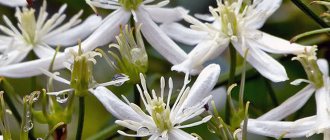Chrysanthemum, how to cover it for the winter. Caring for chrysanthemums in the fall and preparing for winter shelter
It is necessary to begin preparatory work in different regions at different times. The timing sometimes depends not only on the climate, but also on the variety of chrysanthemums. The best thing to do is to wait until the bush begins to bloom and then begin to act. By the way, preparation can also be different:
- Dig up the bush and send it for the winter in a cool place where there is no light.
- Prepare the bush for wintering in open ground.
Now a little more detail about each of the methods.
Digging.
- The bush is dug up and left for a day or two so that the roots and soil on them dry out.
- The stems of the bush are cut off, leaving only cuttings of 17-20 cm.
- Dry soil is poured into the bottom of the pot. The bush is being installed. Add soil to the sides of the pot. When there is enough soil and it completely covers the roots, the soil on top is lightly compacted.
- The cuttings are shortened so that they protrude no more than 3-5 cm above ground level.
In this form, the pots are sent to the basement or other dark, cool place. It is worth digging up one bush from each variety. And leave the rest of the bushes in open ground.
Preparing for shelter.
- At the beginning of autumn, potassium-phosphorus fertilizers are applied under each bush. This will help the root system gain strength for the winter.
- In order for the bush to be covered, it should be pruned. Cuttings should remain no higher than 15cm above the ground. This pruning is carried out immediately after the arrival of the first cold days.
- Cleaning the bush from old leaves and branches.
- If pests or diseases are found on the branches of the bush, it is worth sanitary spraying the bush with antimicrobial or special preparations.
- Cover the bushes, preparing them for wintering.
What and how are chrysanthemum bushes covered? It is worth considering the landing site, climate and expected weather conditions. Why such difficulties? The fact is that in the shelter itself there is also a danger for the bush. Plants cannot tolerate not only severe, prolonged frosts, but also waterlogging. If the shelter is such that it accumulates moisture, the plant may overheat and die.
Gardeners to gardeners
Chrysanthemums are the last flowers of autumn. And they are beautiful in the variety of their shades, shapes and brightness of colors.
When flower beds and flower beds lose their multi-coloredness and turn into gray and featureless areas of the earth, chrysanthemum literally “explodes” this dull picture with a multi-colored fireworks of abundantly blooming and pleasing to the eye bushes.
There are more than two hundred species of chrysanthemum in nature. Most of them grow in the southern regions, but there are also very frost-resistant ones that tolerate cold winters and any weather anomalies in northern latitudes.
The most frost-resistant, hardy and unpretentious is the Korean chrysanthemum. In addition, it is distinguished by the longest flowering - until the onset of stable winter frosts, prolonging the short summer for us.
But the time of its flowering depends entirely on creating comfortable conditions for the plants and good care. Therefore, today we will talk about how to prolong the flowering of chrysanthemums in the autumn garden and how to prepare it for the next season, so that it will delight you with its unearthly beauty next year.
CHRYSANTHEMMA: BIOLOGICAL PORTRAIT
In order to prolong the flowering of chrysanthemums, you need to have a good understanding of its biological characteristics.
Today we will talk about the longest-flowering and unpretentious hybrid Korean chrysanthemum. It is a perennial that grows in the form of a bush or subshrub, usually spherical in shape.
During the long flowering period, chrysanthemums are covered with numerous bright, double and non-double flowers of a wide variety of sizes, shapes and colors, collected in large inflorescences and emitting a wonderful bitter-wormwood aroma.
The beginning of chrysanthemum flowering directly depends on the length of daylight hours. Numerous chrysanthemum buds begin to form after daylight hours last no more than 14–15 hours.
In other words, the Korean chrysanthemum will bloom magnificently in late August - early September (depending on the variety).
This hybrid species was obtained by breeders as a result of numerous crossings of the frost-resistant Siberian chrysanthemum with other small-flowered cultivated species.
Based on the size of the inflorescences, Korean chrysanthemums are divided into:
small-flowered – up to 11 cm in diameter;
large-flowered - more than 12 cm in diameter.
According to the height of the bushes they are divided into:
low-growing - up to 30 cm high, which are most often used to create low borders;
medium-sized - up to 50 cm high. They look good in multi-tiered flower beds as a middle row;
tall - up to 1 m high. They have the most lush and long-lasting flowering.
Tall chrysanthemums are of greatest interest to gardeners. Their powerful bushes with numerous bright flowers look great both in single plantings and in hedges.
Some varieties of Korean chrysanthemum can withstand winter frosts down to -40 degrees. They practically do not get sick and are not damaged by pests.
The most important agrotechnical measures to prolong the lush, bright flowering of chrysanthemums should be carried out in late August - September.
HOW TO CORRECTLY CARE FOR CHRYSANTHEMUMS TO EXTEND THEIR BLOWING IN THE AUTUMN PERIOD
We have already talked in detail about the history of the chrysanthemum culture itself, the emergence of large-flowered and very frost-resistant varieties of Korean chrysanthemum, its planting and agricultural technology in our published article:
"How to grow Korean chrysanthemums."
We would like to dwell in some detail on the most important aspects of these processes.
Landing place . Since chrysanthemum gives us its beauty only at the beginning of autumn, for bright and lush flowering it needs as much heat and sunlight as possible.
Therefore, try to find her a place where she will bathe in the sun all day long and at the same time be in a “quiet” place where there are no drafts and cold autumn winds.
It is best to plant it in a high flower bed (if there are a lot of bushes) or on mounds at least 50 cm high (if planted alone).
soils need very fertile, rich in organic matter, loose, light, well-warmed and neutral. Therefore, when forming a flower bed of 1 sq. m add: two buckets of rotted manure (or compost), leaf soil and sand, a bucket of wood ash, 2 tbsp. spoons of double superphosphate and 1.5 tbsp. spoons of potassium sulfate.
Chrysanthemum does not tolerate heavy acidic soils. She will simply die on them in the first year. Therefore, deoxidize acidic soils in the fall and move planting to spring.
Use crushed chalk or dolomite flour as a deoxidizer (at the rate of 2 kg per 5 sq. m of future planting area).
Landing. In a dug up and fertilized area, dig planting holes with a diameter and depth of 30 - 50 cm (depending on the height of the bush). The distance between the pits is 50 – 60 cm.
After planting, water the bushes well with warm water (at the rate of 1 watering can for each plant) and mulch the ground around them with straw or sawdust in a 5 cm layer.
Watering. Chrysanthemums are powerful plants, especially tall ones, so for lush and long flowering they need a lot of water. Typically, bushes are watered twice a week (20 liters for each bush). In hot summers, water them more often.
To water chrysanthemums, use only warm water, well heated in the sun (its temperature should be at least 20 degrees).
Using cold water for irrigation greatly slows down the growth and development of chrysanthemums. In autumn, the temperature of irrigation water is especially important for plants. Try not to lower it below 22 degrees.
If autumn is dry and warm, water blooming chrysanthemums three times a week. Then the inflorescences will be bright and lush.
Fertilizers. Chrysanthemums especially need them during the autumn flowering period. Naturally, it is strictly forbidden to apply nitrogen fertilizers (as for all other plants).
Nitrogen promotes the rapid growth of green mass and the awakening of dormant buds, which, during preparation for winter, can lead to the death of the plant in winter.
In autumn, give chrysanthemums twice the potassium-phosphorus nutrition and a complex of microelements. For the first time in early September, give the bushes superphosphate and potassium magnesia (2 tablespoons for each bush with shallow loosening).
For the second time, feed the chrysanthemums at the end of October with some ready-made mineral complex for autumn feeding of perennial flowers in the dosage indicated on the package. Apply fertilizers a couple of hours after watering, then the main nutrients will not go into the lower soil horizons.
Autumn pruning. In spring, Korean chrysanthemums usually do not form, since the shape of their bushes has a regular spherical shape. If you want it to be even fuller, pinch the top of each branch after the eighth leaf has formed.
After such an operation, lateral processes will quickly begin to form on each branch.
But in late autumn (end of November), when the chrysanthemum finishes flowering and winter frosts set in and snow falls, cut all the branches of the bush to a height of 10 - 15 cm.
There is no way to prune before, because the Korean chrysanthemum continues to bloom profusely, the bush has not yet fallen asleep, and nutrients must have time to flow from the above-ground part to the roots.
If this does not happen, then next year your Korean chrysanthemum may not bloom.
Shelter for the winter . Mulch the trimmed bushes with spruce branches, laying them in two layers with the needles facing up so that rodents do not get to the roots of the plants.
THE BEST VARIETY OF KOREAN CHRYSANTHEMUM FOR AUTUMN PLANTING
Now that you know how to prolong the flowering of chrysanthemums, all that remains is to choose a reliable and beautifully blooming variety. We have prepared just such for you - a tall, frost-resistant and unpretentious variety of Korean chrysanthemum LELIA.
Lelia is a spherical bush up to 80 cm high with huge clusters of medium-sized, very bright crimson-pink flowers with a darker crimson center. When flowering, the entire plant is enveloped in a delicate, very pleasant lily of the valley aroma with a slight bitterness.
The variety is frost-resistant, withstands winter cold down to -38 degrees. It blooms at the end of August and blooms until the snow falls steadily. Not affected by pests and diseases.
If in November you cut flowering branches from this bush and put them in a vase, they will stay there for another month!
You can read more about the Lelia variety on our website or in the Autumn 2020 catalogue.
And you can buy it from us today!
How to preserve chrysanthemums on the balcony in winter. Storage methods
To preserve chrysanthemum cuttings in winter, you can use several methods: for example, leave them in open ground, dig them up and plant them in pots or in a cellar, place them in a greenhouse or even on a balcony.
It is also important to ensure that the room temperature does not fall below +10 degrees Celsius.
In a flowerpot
Many gardeners keep small plants in pots, placing them in heated rooms. First you need to carefully dig up the flowering bush. In order not to damage the roots in the process, the soil around the bush must first be well watered, wait a little, and only then start digging. In the meantime, you need to start preparing the flowerpot.
It is better to take a wide and not too high pot, because the roots of the chrysanthemum are quite massive.
A drainage layer must be laid at the very bottom. You can use either fine gravel or broken bricks. Then you need to place the chrysanthemum in a flowerpot, and very carefully sprinkle everything with loose substrate.
During flowering, the pot can be placed on or near a well-lit windowsill. When the chrysanthemum has completely faded, you can start pruning it. After this, the flowerpots should be placed in a cool place, for example, in the basement, and stored there until spring. If young shoots appear during this period, they must be broken off immediately. In this case, the flowers will be very lush in summer. When the frosts have completely subsided, chrysanthemums can be planted in a new place.
In the greenhouse
In order to prolong the flowering of chrysanthemums, they must be transplanted into a greenhouse in advance. With the onset of the first frost, all stems will need to be removed, leaving only 2 centimeters of the plant above the ground. After this, wintering bushes must be sprinkled with a layer of dry humus. Its height should not be less than 25 centimeters. In addition, you will need to cover the chrysanthemums with any covering material.
With the onset of spring, you need to take care of the timely opening of the bushes.
If this is not done, then they will simply dry out, that is, die. In the case when the greenhouse is heated and the temperature inside it is within 5 degrees above zero, the plants will not need shelter.
In a container
Very often, buckets, boxes or any other container are used to preserve chrysanthemums in winter. It is necessary to fill the container with peat and coarse sand in equal parts. To store flowers, you can use warm basements or cellars, warm balconies or even sheds. The temperature in such rooms should not rise above +5 degrees and fall below +1 degree Celsius.
It is very important that the indoor climate is always stable.
In the cellar on the floor
The success of this option depends not only on the level of preparation of the plant, but also on how suitable the cellar is in which the chrysanthemum will winter. First of all, the room temperature should be within 3-5 degrees above zero. In addition, the cellar must be well ventilated. It should be free of traces of mold and any insects.
To store in the cellar, the plant must be dug up in late autumn.
This procedure must be carried out quite carefully, without shaking off the soil from the roots. Then the dug up chrysanthemums should be left for several days in the fresh air so that they can dry well. If suddenly the plant is infected, it must be sprayed using special insecticides.
Next, the chrysanthemums must be moved to the basement, where they can be stored directly on the floor or in a specially prepared box. The plants must be laid very tightly to each other, and covered with a layer of earth on top. If the cellar is very warm, the chrysanthemum may sprout in the middle of winter. However, they will be very weak at this time, so it will be better to get rid of them.
Chrysanthemums stored in the cellar do not require special care. It will be enough to inspect them once a month.
When the roots are too dry and limp, they should be sprayed with water. If mold or mildew appears on chrysanthemums, they must be removed from the cellar immediately. Those plants that are not infected are best treated with special antifungal drugs.
In the trench
You can also store chrysanthemums in a trench in winter. However, this is only possible in those regions where the ground does not freeze very deeply. In addition, the snow cover should be quite large. But in the spring it is necessary to clear the trench from snow so that it is dry. The depth of the trench should be between 50 centimeters and one meter.
Gardeners recommend making it narrow: this way the flowers can be preserved much better.
Chrysanthemums must be dug up and placed at the very bottom very tightly to each other. If there are too many plants, they can even be laid in two layers. They should be sprinkled on top with either dry sawdust or dry leaves. Then everything needs to be covered with spruce branches. In addition, you can add another layer of covering material. Boards or slate are suitable for this. You can additionally cover them with film on top. In the spring, the covering material will need to be removed, but this is best done gradually.
Continue watering
Chrysanthemums continue to bloom until frost. It is clear that during this period the plant needs a lot of moisture. The soil in a flower bed with garden chrysanthemums should not be allowed to dry out. If autumn is dry, flowers are watered once a week. It is better to use rainwater for these purposes. It is collected in barrels in advance. The water should not be too cold at the time of watering.
Try to keep moisture away from the stems and leaves (this can cause fungus). It is better to water chrysanthemums from a watering can, without using a divider attachment. The last watering of the season is done abundantly. Its purpose is to properly saturate the soil in order to protect the roots of chrysanthemums from freezing in winter. At least 5 liters of water should be poured under each bush. Immediately after this, the surface of the flowerbed is mulched. Dehydrated chrysanthemums will survive wintering worse.
How to cover spherical chrysanthemums for the winter. How to properly cover chrysanthemums
The method of covering chrysanthemums on the site depends not only on climatic conditions, but also on their type. The main enemies of garden plants in winter are high humidity and lack of snow on frozen ground. The main purpose of covering measures is to preserve the roots and vegetative buds of chrysanthemums. Which shelter is best suited for each variety?
Multiflora
The multiflora group includes low-growing plants with a spherical crown and many small flowers. These chrysanthemums can be stored in the ground in areas with a mild climate, without sudden temperature changes. The trimmed bushes are hilled to a height of 10-15 cm, making sure that no holes are formed nearby where water could subsequently accumulate. You need to start sheltering no earlier than the temperature drops to zero. With the arrival of more severe frosts, you can throw spruce branches and dry leaves on top, and later add snow mass as insulation. Where the soil does not freeze too much, the trench storage method is suitable.
On a note! For better preservation of flowers in trenches, dig holes that are not too wide (20-30 cm will be enough).
The depth of such a trench can vary from 0.5 to 1 m. Prepared and trimmed plants are placed in the trench close to each other; small specimens can be arranged in 2 layers. The remaining space is filled with loose, dry soil. The shelter is covered from above with a layer of foliage or spruce branches, and then with boards and roofing felt. As the last layer, a film is placed, on which leaves are also thrown, and then fallen snow is added. In spring, the shelter should be dismantled gradually, without removing all layers at once. Multiflora can also be stored together with a lump of earth in a basement or cellar.
Globular
In the southern regions, covering spherical chrysanthemums with spruce branches or straw with preliminary mulching of the roots will be sufficient. In the conditions of Siberia and the Urals, these delicate plants will not tolerate frost, so they are dug up after the above-ground part has dried, dried in a shaded place, the remains of the stems are cut off, cleaned of adhering earth and placed in containers with sawdust or chopped straw. Store rhizomes until spring in a cool, dark room.
Globular chrysanthemum. How to preserve in winter:
Korean
Korean chrysanthemums are distinguished by the greatest frost resistance. In warm climate zones, simple hilling is enough for them without the construction of additional shelters. If these plants die in winter, it is often not from frost, but from damping off. It is recommended to hill them up to a small height with a layer of loose soil, and then arrange a ventilated shelter from spruce branches. You can also build walls of several bricks around the perimeter of the plant, and put a layer of slate or roofing felt on top. The air remaining inside the shelter will not allow the plants to escape.
Dwarf
Dwarf chrysanthemums need careful insulation if they overwinter in open ground. The stems, cut to a height of 10-12 cm, are completely covered with dry soil, peat or leaves, and any covering material is thrown on top. The number of layers in the shelter depends on the growing region. If the winter is frosty, at least 2-3 layers of covering material are required. Some varieties of dwarf chrysanthemums do not tolerate wintering outside at all. They are moved to a bright and cool place, for example, stored on a glazed balcony or in the entrance of an apartment building, also pre-cut to a height of 10 cm.
In the greenhouse
If there is a stationary greenhouse at your summer cottage, you can successfully store chrysanthemums in it in winter. Flowers are transplanted inside the building during the flowering period, which prolongs the period of bud formation. When frost begins to dominate the street, the freezing stems of chrysanthemums will need to be cut off, leaving stumps 3-4 cm high. After this, the plants are covered with a layer of humus to insulate the roots and prevent them from freezing in extreme cold. If the winter is frosty, the thickness of the mulch layer should be 20-25 cm. Several layers of thermal insulation material are laid on top. In spring, chrysanthemums will need to be opened as soon as the outside temperature reaches above zero.
When to cover, at what temperature
The peculiarity of covering measures for chrysanthemums is that they build shelters for them late - when the soil begins to freeze, and remove them in early spring so that the bushes do not dry out. By the time of construction, snow may already have fallen. If the snow cover has not yet settled, but the temperature outside has already set below zero, then it’s time to cover the chrysanthemums. Each region has its own sheltering periods, determined by the peculiarities of the local climate.
In the Moscow region, middle zone
Gardeners often make the mistake of covering bushes during the autumn rains at above-zero temperatures. Under no circumstances should this be done. By insulating a wet bush, you provoke the development of fungal diseases, which are favored by a humid environment. Chrysanthemum easily tolerates low sub-zero temperatures. You will need to cover it on a dry, clear day with light frost (up to -7 degrees). In the middle zone and Moscow region, suitable weather sets in the last days of October or early November. The bushes should be pruned by this time.
Wintering chrysanthemums in the Middle Zone: video
In the Urals
In the Urals, chrysanthemums winter even more safely than in the middle zone. This is due to the lack of thaws in the winter months and the significant thickness of the snow cover. Due to harsh winters and strong winds, the shelter must be reliable. In the Southern Urals, bushes are left to overwinter in the ground. Gardeners of the Northern Urals prefer to dig up chrysanthemums and store pots in the basement with plants cut to the stump.
You can temporarily plant chrysanthemums in plastic pots or even cake boxes. Before storing the soil, lightly water it. During the winter it is also necessary to moisten the soil several times. Bushes left to winter in open ground are covered at the end of October, after the arrival of a slight frost.
In Siberia
In this climate zone, there can be extremely low temperatures in winter, so experts recommend that Siberian summer residents dig up chrysanthemums for the winter and store them in a room with a positive temperature of 0 to 5 degrees. It is better if the plants have access to light. Bushes that overwinter in a dark room come to spring more weakened. The ideal humidity level for storing chrysanthemums is 75%. The plants are dug up along with a lump of earth, having previously cleared the bush of wilted shoots and leaves.
In the Leningrad region
The climate of the Leningrad region is treacherous, since there are often thaws in the first half of winter, and there is always high air humidity. Winter-hardy varieties of chrysanthemums are suitable for cultivation here, which, however, necessarily require shelter. It is better to dig up especially valuable and expensive varieties and store them in the basement so as not to take risks. Cover the bushes at the first frost in clear weather. The covering method depends on what kind of chrysanthemums are grown on the site. The insulation of the flower beds begins in the last ten days of October. Dates may shift in either direction due to the vagaries of the weather.
How to cover a multiflora chrysanthemum for the winter. Rules for preparing plants for wintering
Helping the plant transition through winter is an integral part of every gardener’s autumn work. And in the case of chrysanthemums, this rule also applies. From the very beginning, it is necessary to carefully monitor the slightest manifestations of painful lesions on the shoots, leaves and flowers of the plant.
If such ailments have been discovered, then you need to deal with them as quickly as possible, completely eliminating the lesion and preventing its further spread throughout the flower rosette. But the plant requires especially careful control over pests during the onset of autumn and preparation for a long winter. It is very important here to maintain the healthy state of the entire plant in order to prevent the progression of the disease throughout the winter, because this may determine whether your chrysanthemum will overwinter or die.
Important points are also high-quality watering and fertilizer. During spring and summer, it is necessary to water the chrysanthemum correctly.
Did you know? The chrysanthemum is the national symbol of Japan. This country even has the highest award - the Order of Chrysanthemums.
As for fertilizing, in the spring you need to add something that will promote active growth and flowering, but this cannot be done in the fall. In the autumn, you need to feed chrysanthemums, which will maintain its healthy and strong appearance, and also protect it from freezing and death in the cold season.
After the arrival of the first serious cold weather, the chrysanthemum can be pruned from old, outdated or dried shoots.
Important! It is worth carrying out activities for pruning chrysanthemums as late as possible so that the juice from all shoots, even dying ones, goes into the trunk. This way you will protect your flora representative from unwanted sap loss and, accordingly, death in winter.
At the same time, a final inspection of the plant is carried out for putrefactive or mold damage. If any are found, there is no need to stand on ceremony with them, but clean everything thoroughly to prevent further infection.
In addition, the main, strong shoots should be shortened to 10-15 cm, while, as a rule, young shoots are not touched.
Chrysanthemum multiflora is a line of small-flowered, low-growing chrysanthemums with lush, dense and abundant flowering. This group has a genetic spherical shape, for which it is also called globular chrysanthemum. Chrysanthemum multiflora is not a capricious flower; the rules for planting and caring for it are quite simple.
What varieties should you dig?
“Multiflora” chrysanthemums, large-flowered and branched varieties must be removed from the soil. It has been noted that plants with large inflorescences do not tolerate wintering well in the ground. They are removed from the ground after the onset of cold weather and sent for storage in a dry basement.
Indian varieties especially need a gentle wintering:
- Golden Orpheus;
- Helen, etc.
Similar plants can be transplanted into greenhouses, insulated loggias or greenhouses.
Healthy!
In those regions where there is a short season with positive temperatures, it is recommended to grow chrysanthemums for cutting in heated greenhouses. If chrysanthemums are grown for decorative purposes, you should pay attention to Korean varieties with small inflorescences.
Popular varieties of small-flowered chrysanthemums are:
- Oak;
- Red Moscow;
- Purple Haze;
- Everest;
- Korean;
- Malchish-Kibalchish;
- Chamomile, etc.
In all regions with a warm climate, they can be left in the ground for the winter, having previously taken care of the shelter without the risk of freezing.
You may be interested in:
About the dates for digging up tulips after flowering Gardeners who grow tulips know how important it is to dig up the bulb correctly and preserve...Read more...
You need to come to the right decision whether to dig up or leave chrysanthemums in the ground after reading useful information. The climatic conditions of the region should be taken into account. It is known that all plants are perfectly preserved under a layer of snow, even in harsh winters. But if the cold season passes without snow and with severe frosts, then chrysanthemums may not withstand such conditions and die. The same damage to the roots will be caused by frequent alternations of thaw and frost, and prolonged precipitation in the form of rain.
The second important factor to consider is the chrysanthemum variety. For the middle zone and Moscow region, Korean hybrid varieties are preferred. When purchasing a plant you like, it is important not to make a mistake and buy a garden flower, not an indoor flower.
Advice!
Planting and caring for chrysanthemums is of great importance. A well-chosen place in the garden will determine whether the root system will dry out during prolonged thaws.
Planting of newly acquired bushes should begin no later than the end of August in order to give the chrysanthemum time to fully take root. Phosphorus fertilizers are added to the planting hole, and the plant will need nitrogen fertilizers in the spring. Fertilizing with potassium fertilizers is used during the warm season for abundant flowering.
How to cover chrysanthemums for the winter in Siberia. How to store chrysanthemums in the cellar in winter
Despite the fact that chrysanthemum is a cold-resistant plant, in some years it may freeze without shelter. In order not to take risks, for fear of ruining a rare variety, chrysanthemums can be placed in the cellar for the winter. In one of
- Around mid-November, a chrysanthemum bush is dug up and placed in a pot.
- The branches are broken off, leaving only the tip of the stem (stump).
- The lump of earth with roots is sprinkled with dry soil on top.
- In this form, the pot is placed in the cellar, and in the spring the plant is planted again in open ground.
Important:
- You should not dig up the plant too close to the stem, because the roots of the chrysanthemum can be up to 20 cm from the stem.
- Before placing a lump of earth with roots in a pot, you can let the soil dry slightly, this will help avoid rotting of the root system during wintering.
- There is no need to water the chrysanthemum in the cellar, otherwise the new shoots that come from the root will begin to grow, stretch out, deplete the root, and all this will be harmful to the plant. If you see that the soil in the pot has become excessively dry, you can add a couple of handfuls of snow or moisten it with a spray bottle.
- Do not pack the plant in a plastic bag. The soil will accumulate condensation under the film, the roots and shoots will rot, and the plant may die from this.
If the variety is new, growing for the first year, and you don’t know how it tolerates winter, leave some of the young shoots to overwinter in the soil. Cover them with soil to prevent them from freezing. And in spring and autumn, see what happens to them. If they survive, they will bloom - you don’t have to dig up this variety of chrysanthemums every year, but leave them to winter in open ground.
It seems to many that chrysanthemums feel great in winter without any additional care. In fact, if you do not provide any care to chrysanthemums in the fall, then in the spring you will get weak bushes that are prone to disease. And then - if the plant manages to overwinter, and it does not freeze or dry out.
Therefore, if you want your chrysanthemum to be healthy and pleasing to the eye, pay a little attention to it in the fall.
Autumn events
Despite the fact that the chrysanthemum is not a delicate flower, it is unlikely to survive winter in the open ground without preliminary preparation. Preparatory work should begin at the end of August.
If the flowers grew without care during the summer, you will have to carry out a whole range of measures to prepare chrysanthemums for winter:
- Inspection of the plant. It is recommended to preserve only healthy bushes. They can withstand temperature changes more easily and adapt well to frost.
Removing old stems and remaining foliage. This stage is mandatory, since it is in fallen leaves and debris that garden pests like to settle.
- Bush pruning. It is customary to leave stumps 515 cm high (depending on the intended method of covering). When to prune chrysanthemums for the winter, the gardener decides on his own. This is usually done with the establishment of cold weather, a persistent drop in temperature.
- Treatment of flowers with drugs.
- Fertilizing the soil (with complex fertilizers with a high content of potassium and phosphorus).
- Pre-winter watering.
How to store chrysanthemums in pots in winter. Storage methods
To preserve chrysanthemum cuttings in winter, you can use several methods: for example, leave them in open ground, dig them up and plant them in pots or in a cellar, place them in a greenhouse or even on a balcony.
It is also important to ensure that the room temperature does not fall below +10 degrees Celsius.
In a flowerpot
Many gardeners keep small plants in pots, placing them in heated rooms. First you need to carefully dig up the flowering bush. In order not to damage the roots in the process, the soil around the bush must first be well watered, wait a little, and only then start digging. In the meantime, you need to start preparing the flowerpot.
It is better to take a wide and not too high pot, because the roots of the chrysanthemum are quite massive.
A drainage layer must be laid at the very bottom. You can use either fine gravel or broken bricks. Then you need to place the chrysanthemum in a flowerpot, and very carefully sprinkle everything with loose substrate.
During flowering, the pot can be placed on or near a well-lit windowsill. When the chrysanthemum has completely faded, you can start pruning it. After this, the flowerpots should be placed in a cool place, for example, in the basement, and stored there until spring. If young shoots appear during this period, they must be broken off immediately. In this case, the flowers will be very lush in summer. When the frosts have completely subsided, chrysanthemums can be planted in a new place.
In the greenhouse
In order to prolong the flowering of chrysanthemums, they must be transplanted into a greenhouse in advance. With the onset of the first frost, all stems will need to be removed, leaving only 2 centimeters of the plant above the ground. After this, wintering bushes must be sprinkled with a layer of dry humus. Its height should not be less than 25 centimeters. In addition, you will need to cover the chrysanthemums with any covering material.
With the onset of spring, you need to take care of the timely opening of the bushes.
If this is not done, then they will simply dry out, that is, die. In the case when the greenhouse is heated and the temperature inside it is within 5 degrees above zero, the plants will not need shelter.
In a container
Very often, buckets, boxes or any other container are used to preserve chrysanthemums in winter. It is necessary to fill the container with peat and coarse sand in equal parts. To store flowers, you can use warm basements or cellars, warm balconies or even sheds. The temperature in such rooms should not rise above +5 degrees and fall below +1 degree Celsius.
It is very important that the indoor climate is always stable.
In the cellar on the floor
The success of this option depends not only on the level of preparation of the plant, but also on how suitable the cellar is in which the chrysanthemum will winter. First of all, the room temperature should be within 3-5 degrees above zero. In addition, the cellar must be well ventilated. It should be free of traces of mold and any insects.
To store in the cellar, the plant must be dug up in late autumn.
This procedure must be carried out quite carefully, without shaking off the soil from the roots. Then the dug up chrysanthemums should be left for several days in the fresh air so that they can dry well. If suddenly the plant is infected, it must be sprayed using special insecticides.
Next, the chrysanthemums must be moved to the basement, where they can be stored directly on the floor or in a specially prepared box. The plants must be laid very tightly to each other, and covered with a layer of earth on top. If the cellar is very warm, the chrysanthemum may sprout in the middle of winter. However, they will be very weak at this time, so it will be better to get rid of them.
Chrysanthemums stored in the cellar do not require special care. It will be enough to inspect them once a month.
When the roots are too dry and limp, they should be sprayed with water. If mold or mildew appears on chrysanthemums, they must be removed from the cellar immediately. Those plants that are not infected are best treated with special antifungal drugs.
In the trench
You can also store chrysanthemums in a trench in winter. However, this is only possible in those regions where the ground does not freeze very deeply. In addition, the snow cover should be quite large. But in the spring it is necessary to clear the trench from snow so that it is dry. The depth of the trench should be between 50 centimeters and one meter.
Gardeners recommend making it narrow: this way the flowers can be preserved much better.
Chrysanthemums must be dug up and placed at the very bottom very tightly to each other. If there are too many plants, they can even be laid in two layers. They should be sprinkled on top with either dry sawdust or dry leaves. Then everything needs to be covered with spruce branches. In addition, you can add another layer of covering material. Boards or slate are suitable for this. You can additionally cover them with film on top. In the spring, the covering material will need to be removed, but this is best done gradually.
Feeding flowers in autumn
In order for the chrysanthemum to successfully overwinter, it is necessary to take care of feeding in the autumn.
Feeding should begin approximately 35-40 days before cold weather sets in, during which time the plant’s root system will take on all the elements it needs.
It is recommended to use mixtures in which:
- Potassium.
- Phosphorus.
They are the ones that accumulate in the root system and help the plant to survive the winter safely.
You can purchase a ready-made mixture for fertilizing and fertilize it according to the included instructions. Or you can prepare the mixture yourself:
- superphosphate – 40 grams;
- potassium salt (potassium sulfate) – 30 grams.
The mixture is enough for one square. m.
Store-bought mineral fertilizers can be replaced with wood ash mixed with bone meal 1:1. For one sq. m. you will need 100 grams of ash.
Before applying fertilizers, the soil should be well moistened. Everything is scattered evenly over the surface, then the soil can be loosened shallowly. Each subsequent watering will deepen the feeding closer and closer to the roots.
In autumn, nitrogen fertilizers such as urea should not be used. This will provoke foliage growth, which will weaken the plant and in winter it may die.
A couple of weeks after the autumn fertilizing, you can carry out prevention against various diseases and pests. Choose the warmest day and carry out the procedure of your choice:
- Treat with Bordeaux mixture (sold in stores along with instructions for use).
- Treat with foundationazole (20 g of the drug per 10 liters of water).
Insecticides are good for aphids and spider mites. Everything needs to be treated, the stems and foliage, the soil around the flowers, and even if the plant looks healthy, do not skip it.
How to cover chrysanthemums for the winter in the Urals. Sheltering chrysanthemums for the winter
If you are ready to leave your chrysanthemums in open ground for the winter (frost-resistant small-flowered varieties tolerate this procedure best), after fertilizing, pruning and hilling, they need to build a suitable shelter.
How to cover chrysanthemums for the winter? The size and monumentality of the shelter again depends on the climate in your region. And if in the southern regions it will be quite enough to cover the trimmed chrysanthemum bushes with a half-meter layer of dry leaves or hay and cover them with spruce branches, then in the more northern regions the issue will have to be resolved thoroughly.
For a reliable frame shelter, you can use wooden boxes, pieces of slate, boards - and then cover it all with a thick layer of deciduous or hay mulch and cover it with a light, breathable covering material, such as spunbond, and secure it with stones or bricks.
It is better not to use polyethylene film that is impermeable to air, because... as a result of sudden warming, it will provoke a greenhouse effect, which will lead to damping off of chrysanthemums.
In the spring, with the arrival of the first warmth, the protective layer is gradually removed.
Proper preparation of any plants for wintering (including chrysanthemums of all varieties) is the key to their good health and excellent appearance next season. Take a little time in the fall to create suitable conditions for them before the onset of cold weather - and the plants will definitely thank you with lush flowering next year.
Basic mistakes when caring
Mistakes made by flower growers when caring for chrysanthemums and preparing them for the winter:
- do not fertilize flowers in a timely manner (late summer - early autumn);
- do not dig up cut flowers and large-flowered varieties for the winter;
- do not cover chrysanthemums wintering in open ground.
There is nothing difficult about preparing chrysanthemums for the winter. If you properly care for the flowers during the season, then in the fall all that remains is to cover them or put them indoors. Compliance with all the rules for caring for chrysanthemums will allow you to preserve them in the winter.
Pruning chrysanthemums in autumn
Autumn pruning of chrysanthemum stems is carried out to achieve the following goals:
§ removed old, dry shoots affected by fungal infections or pests can rot under winter cover and become a source of infection of healthy bushes;
§ short stems require less nutrients, which are spent on winter survival and subsequent spring development of new shoots;
§ pruned bushes are easier to store at home, and they are also easier to care for and properly covered for the winter.
Chrysanthemum bushes are pruned immediately after flowering or upon the onset of persistent cold weather. All branches are shortened to 10–15 cm with a sharp, disinfected instrument (knife, pruning shears, etc.). The cut is made at a right angle.
It is recommended to treat cutting blades with alcohol, hydrogen peroxide or potassium permanganate solution before pruning each plant to avoid the possible transfer of pathogens.











